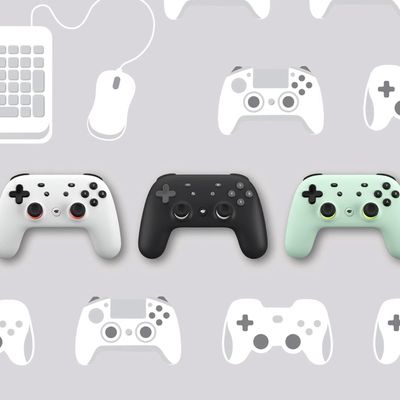
In a prerecorded presentation on Thursday, Google answered some of the looming questions about Stadia, its game-streaming platform that seems poised to take on the likes of Microsoft, Sony, and Nintendo as a new major presence in the video-game industry. The elevator pitch for Stadia is that it is hardware-agnostic: the game software runs on a remote server in a Google data center, and the video feed of that is beamed to the user’s screen. They can then control it with whatever input device they want, whether that’s their keyboard and mouse, a controller they already own, or Google’s own Stadia-specific controller. If the gambit works, it could represent a seismic shift in the game industry, not unlike streaming video from Netflix or music from Spotify.
Google finally revealed details like pricing and the tech specs required to play games on Stadia. If you want to play it this year, you’ll need to sign up for Stadia Pro, which costs 10 dollars a month (a free tier is launching in 2020). If you have a decently fast connection, Google says you’ll have parity with top-performing video-game consoles currently on the market, but if not, you’ll still be able to have a relatively comfortable experience.
The upsides of a system like Stadia are substantial. You don’t have to wait for games, which are often dozens of gigabytes in size these days, to download. You don’t have to buy additional hardware, like an expensive home console or PC graphics card. “Our vision is to run on any screen that runs Chrome,” Stadia head Phil Harrison said. In contrast, Sony has already announced the PlayStation 5, and both it and Microsoft are on the verge of releasing major console updates, likely next year. Meanwhile, GPU-manufacturer Nvidia is pushing a line of expensive, new graphics cards with “ray-tracing” technology.
The whole game industry seems to be headed in the same direction as Google. In addition to new hardware, Microsoft is working on a Stadia competitor known as xCloud, also slated to launch later this year. Nintendo has been testing streaming games to its relatively low-powered Switch system in Japan. Last month, rivals Sony and Microsoft signed a memorandum of understanding “to collaborate on new cloud-based solutions for gaming experiences.” In layman’s terms, Sony is acknowledging that it probably needs to use Microsoft’s cloud-computing infrastructure to keep pace (the PlayStation division was reportedly caught off-guard by the announcement).
Sony’s agreement with Microsoft reveals the central tension of a system like Stadia: the convenience it offers consumers can only exist at a large scale, powered by a company with deep pockets and tons of physical infrastructure, and in exchange, consumers give up long-held privileges — like the ability to own the games they play. There are few companies with the resources (engineers, data centers, the ability to operate at a loss financially) to pull this off, and Google and Microsoft are two of them. Repeatedly throughout today’s presentation, game developers launching on Stadia talked about “bandwidth” and “infrastructure” and the intense load that hosting a reliable ultra-HD video stream that can respond to button inputs with super-low latency entails.
Video-game streaming like Stadia is effectively hardware as a service, and it cements the dominance of the tiny group of major players that can offer it. The Sony-Microsoft agreement turned a few heads; one company asking its rival for technical support. By shifting to a cloud-based system, Google and Microsoft, two of the biggest cloud providers, are cementing control over the platform. Even rivals now need to build platforms atop the platforms of others. By doing this, it also means less consumer control. Just like shows disappear from Netflix, or apps can get pulled for violating App Store guidelines, moving games from a system dependent on hardware ownership to a service requires giving up control to tech giants who already wield a lot of power.
When Google first unveiled Stadia in March, its intention seemed less clear. Much of the presentation was focused on features that seemed more novel than essential — easily pulling up walk-through clips from YouTube, sharing easily to YouTube, seamlessly entering multiplayer scenarios and sharing save states. The messaging was devoted to what set Stadia apart, extolling new features. Only one game in today’s announcement, a goofy co-op title called Get Packed that seemed to cater to livestream users and Let’s Play videos, seemed to fit this tone. Instead, the new details made it abundantly clear, however, that Google is trying to compete with other major video-game platforms directly for market share instead of existing in parallel. The list of games on its launch lineup was full of multi-platform titles also appearing elsewhere this fall (Ghost Recon: Breakpoint, Destiny 2, Mortal Kombat 11), all of which require low latency to be playable. A twitchy, reflex-intensive fighting game like Mortal Kombat struggles with this even when the game is running locally; Google bringing it to Stadia is a clear signal of confidence that it can reach parity with more established competitors.
It’s an aggressive move, trying to compete for the attention of so-called “core” gamers, rather than doing something markedly different. Nintendo has often distinguished itself by being drastically different from Sony and Microsoft with unconventional hardware like the Wii and Switch. Google, on the other hand, is diving straight in, pledging that Stadia will be no different than a standard console experience (Destiny developer Bungie is even letting players port their character progress over from other platforms). Google could easily set up Stadia as an entry-level platform for people who don’t play video games regularly or obsessively, one that a user can jump into with the push of a button. Instead it’s diving straight into the fray, trying to convert current enthusiasts and lure them away from other platforms.






























